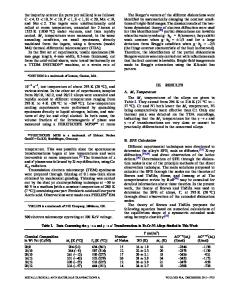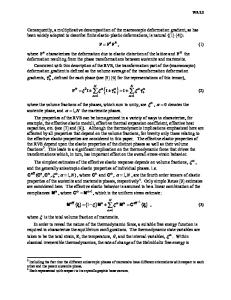The role of irradiation on deformation-induced martensitic phase transformations in face-centered cubic alloys
- PDF / 870,616 Bytes
- 12 Pages / 584.957 x 782.986 pts Page_size
- 42 Downloads / 928 Views
Theroleofirradiationondeformation-inducedmartensitic phase transformations in face-centered cubic alloys Janelle P. Wharry1,a)
Keyou S. Mao2
1
School of Materials Engineering, Purdue University, West Lafayette, Indiana 47905, USA Oak Ridge National Laboratory, Oak Ridge, Tennessee 37830, USA a) Address all correspondence to this author. e-mail: [email protected] This paper has been selected as an Invited Feature Paper. 2
Received: 18 December 2019; accepted: 20 March 2020
Localized deformation, including that by the deformation-induced shearing martensitic phase transformation, is responsible for hardening and embrittlement in irradiated face-centered cubic alloys. These localized deformation processes can have profound consequences on the mechanical integrity of common structural metals used in extreme radiation environments such as nuclear reactors. This article aims to review and understand exactly how irradiation affects the martensitic phase transformation in face-centered cubic alloys, with an emphasis on austenitic stainless steel, given its ubiquity in the archival literature. The influence of irradiation on stacking fault energy and subsequent implications on the phase transformation are discussed. Mechanisms by which irradiation-induced microstructures enhance the phase transformation are also described, including the surface energy contribution of irradiation-induced cavities (i.e., voids and bubbles) toward the critical martensite nucleation energy, and partial dislocation–cavity interactions. A deformation mechanism map illustrates how irradiation-induced cavities can modulate the martensitic transformation pathway.
Introduction Irradiation of metals and alloys with energetic particles causes severe degradation of mechanical performance, most notably through hardening and embrittlement. These phenomena dramatically compromise the safety, operating margins, and lifetime of structural and cladding components of nuclear fission and fusion reactors. Mechanistically, the most significant contributor to irradiation hardening and embrittlement in face-centered cubic (fcc) metals and alloys tested at low temperatures (i.e., ≲400 °C, outside of the creep regime) is the tendency toward localized deformation [1, 2, 3]. Localized deformation in fcc metals and alloys can occur through several modes, including dislocation channeling [4, 5], slip [6], twinning [7], and the so-called martensitic phase transformation [8, 9]. The martensitic transformation is a diffusionless phase transformation, wherein fcc c Fe austenite reverts to hexagonal close-packed (hcp) e martensite or bodycentered cubic (bcc) a9 martensite. All of the aforementioned localized deformation mechanisms are known to interact in a complex manner [10]. In nonirradiated materials, these mechanisms and their interactions are dependent upon
ª Materials Research Society 2020
deformation temperature, strain, strain rate, and stacking fault energy (SFE). Meric de Bellefon and van Duysen [10] have recently reviewed these low-temperature deformation me
Data Loading...











